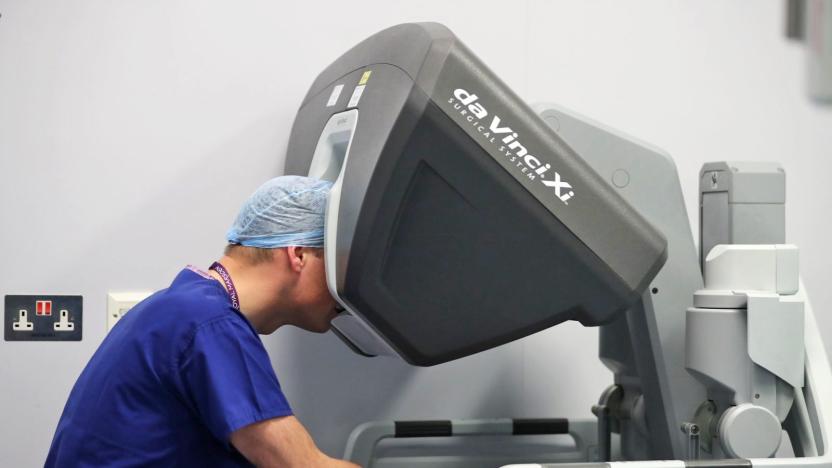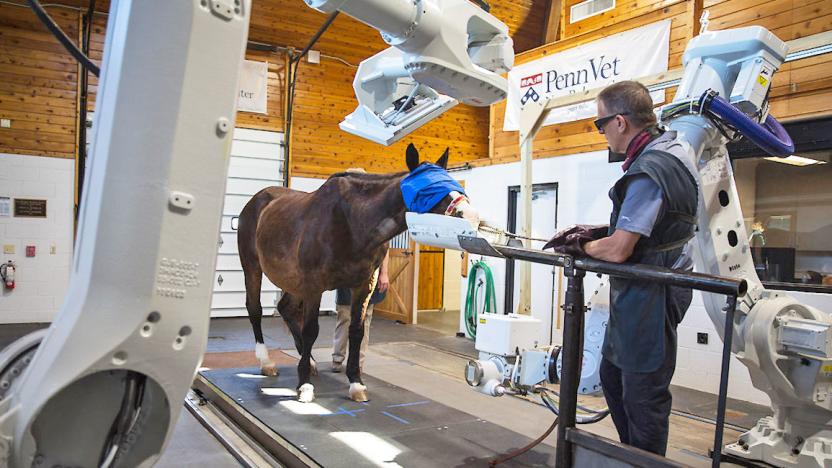UniversityOfPennsylvania
Latest

Honda teams up with MIT and others to develop curious AI
Honda is teaming up with three universities on a project aimed at developing curious artificial intelligence. The new three-year initiative, dubbed the Curious Minded Machine, will work towards an intelligent system that can learn continuously, much like a human, and can actually "learn to learn," as children do. "Our ultimate goal is to create new types of machines that can acquire an interest in learning and knowledge, and the ability to interact with the world and others," Soshi Iba, a principal scientist at the Honda Research Institute, said in a statement. "We want to develop Curious Minded Machines that use curiosity to serve the common good by understanding people's needs, empowering human capability and ultimately addressing complex societal issues."

Penn doctors perform the first robot-assisted spinal surgery
Surgical robots are capable of feats that even the most skilled doctors can't manage, and the University of Pennsylvania just offered a textbook example. The school has confirmed that it performed the first-ever robot-assisted spinal surgery, using Da Vinci's robotic arms to remove a rare tumor where patient Noah Pernikoff's spine met his skull. The two-day operation, which took place in August 2017, started with neurosurgeons preparing the spine using ultrasonic cuts, and then brought in the robot to clear a path for removing the tumor through Pernikoff's mouth (you can see a slightly graphic illustration below). The team then used some of Pernikoff's own bone to reconstruct the spinal column section they'd removed.

First human CRISPR study in the US could begin soon
In mid-2016, A federal panel had greenlit the University of Pennsylvania to pursue the first trials using CRISPR gene-editing in the US. It seems the institution has quietly gotten the ball rolling and could theoretically start the study at any time: A posting was found on a directory of trials describing a yet-to-be-scheduled UPenn survey using CRISPR techniques to treat cancer patients.

ICYMI: The US Marines want your robots
try{document.getElementById("aol-cms-player-1").style.display="none";}catch(e){}Today on In Case You Missed It: The US Marine Corps announced its latest Innovation Challenge for robots that can handle dull, dirty or dangerous work autonomously, leaving humans free for more important tasks. Meanwhile the University of Pennsylvania has a researcher flying a quadcopter through 45-degree angle window openings at top speeds, with few extra onboard sensors. The algorithm behind it is neat, even if the potential applications make us uncomfortable. You may already know why we should be covering up our computer webcams, but here's more ammo if that's needed. As always, please share any interesting tech or science videos you find by using the #ICYMI hashtag on Twitter for @mskerryd.

ICYMI: Racecar drivers are being replaced by computers
try{document.getElementById("aol-cms-player-1").style.display="none";}catch(e){}Today on In Case You Missed It: Formula E racing is gearing up for new robo-races with the DevBot, a hybrid vehicle that can be driven by a computer rather than a person. Meanwhile, researchers at the University of Pennsylvania tested injecting a new hydrogel into animals and find that it helps thicken up weak, damaged tissue after heart attacks. If you want to test out the Trump chatbot, that's here, though a look at the candidate's Twitter account will deliver the same information. Drone enthusiasts here for the Gameboy Classic controller will find the original video on YouTube. As always, please share any interesting tech or science videos you find by using the #ICYMI hashtag on Twitter for @mskerryd.

ICYMI: Robot running buddy, mechanical sea life and more
#fivemin-widget-blogsmith-image-97080{display:none;} .cke_show_borders #fivemin-widget-blogsmith-image-97080, #postcontentcontainer #fivemin-widget-blogsmith-image-97080{width:570px;display:block;} try{document.getElementById("fivemin-widget-blogsmith-image-97080").style.display="none";}catch(e){}Today on In Case You Missed It: A horse-sized, standing CT scanner has been invented to keep your equine pals from being tranquilized before images are taken; a sea urchin mouth was used as inspiration for a robot that could be sent to Mars to collect samples; and NASA engineers and MIT students created a robot for Puma that can be programmed to 'race' training runners. If you're less of a runner, more of an observer, the Kung Fu art of Tobias Gremmier may be more your speed. As always, please share any great tech or science videos you find by using the #ICYMI hashtag on Twitter for @mskerryd.

Equine CT scanner can peek inside standing, conscious horses
Horses are majestic creatures, but one thing they are not is tiny. Well, not for long, anyway. That creates a problem for equine medicine. When an animal weighs just under an imperial ton and is six-foot tall at the shoulders, there's only so much a veterinarian can do while the animal is still conscious. To that end, the University of Pennsylvania School of Veterinary Medicine (phew) is partnering with imaging outfit 4DDI to make free-standing CT scans a reality. Dubbed "Equimagine," the setup uses a pair of robotic arms that can gather internal images of a horse while it's awake and standing on all fours.

Napster co-founder's new institute aims to beat cancer
Sean Parker is known for many things: co-founding Napster, joining Facebook in its early days, starting charities and creating his share of technology startups. If all goes well, though, he'll also add "helped cure cancer" to that list. He just founded the Parker Institute for Cancer Immunotherapy, a $250 million effort to fight cancer by relying on the body's immune system. The organization will unite six universities (covering 40 labs and over 300 scientists), encouraging them to share research rather than compete. As Parker puts it, humanity is on the "bleeding edge" of what you can do with synthetic biology... it might just need a nudge to turn those findings into real-world treatments.

Just add water and this squid-inspired plastic heals itself
While you've been busy scarfing down fried calamari rings, scientists at the University of Pennsylvania have been doing something else with squid. Namely? Studying the cephalopod's ring teeth for a way to create a material that heals when water's present, much in the way that those tentacle-bound choppers do. The way the report spotted by Popular Science tells it, the researchers were able to reproduce the type of proteins found in the self-healing squid teeth and trigger bacteria to make it in a lab environment.

ICYMI: Head injury alert, zombie killing centers and more
#fivemin-widget-blogsmith-image-604354{display:none;} .cke_show_borders #fivemin-widget-blogsmith-image-604354, #postcontentcontainer #fivemin-widget-blogsmith-image-604354{width:570px;display:block;} try{document.getElementById("fivemin-widget-blogsmith-image-604354").style.display="none";}catch(e){}Today on In Case You Missed It: Google is putting its glut of satellite imaging data to good use with the "Sunroof" database, which helps people check their homes and figure out if they get enough sun to install solar panels. University of Pennsylvania researchers made a polymer that changes color depending on the depending on the amount of force used against it. They're hoping to make helmets that quickly signal the degree of a possible brain injury. And Australians beat the Americans to the virtual reality laser tag fun zone finish, building a VR zombie killing gaming center ahead of the U.S. one slated to open next year.

Color-changing helmets could warn you about head injuries
Head injuries can be particularly sinister -- unless it's obvious that you took a bad blow, you might not get the help you need in time to mitigate the damage. University of Pennsylvania scientists may have an easy way to raise the red flag when you're hurt, however. They've crafted a polymer that changes color depending on the amount of force, giving anyone around you a sign that you've suffered some trauma. The key was to use holographic lithography to create photonic crystals whose structures change color when they deform. They don't require any power to work, and they're light enough that you could apply them to a helmet without noticing a significant weight difference.

Study says phones are just as good as wearables at tracking fitness
Think you have to wear a dedicated fitness tracker to get accurate data? Don't worry -- you may have a good excuse to skip the wristband. The University of Pennsylvania has published a study showing that smartphone apps' step counts are reasonably on the mark, at less than a 7 percent variance between their data and what observers saw first-hand. With wearables, it's all over the map. Some are very accurate, like Fitbit's One and Zip; others don't give you much of an advantage over a phone, and Nike's Fuelband was sometimes off by a wide margin.

RHex robot uses leaping ability to do 'Parkour' (video)
It's easy for a robot to perform in a sterile lab environment, but only a select few devices -- like Boston Dynamics notorious AlphaDog -- have proven themselves in the wild. However, the University of Pennsylvania's X-RHex Lite has also made that leap, as it were, and a new video shows just how talented it's become. In it, the droid puts all of its running, jumping and grabbing talents together to perform flips, chin-ups and even Parkour-like moves over campus obstacles. The researchers hope it'll perform rescue missions or research in tough environments one day, but until then, gaze in awe at the video after the break.

X-RHex Lite robot leaps across gaps in a single bound (video)
Move aside, Sand Flea, you're not the only jumping robot in town. The researchers over at the University of Pennsylvania have taught their little six-legged X-RHex Light to make leaps and bounds as well, making it one of a few bots to both run and jump effectively. While it can't spring as high as the Boston Dynamics critter, the X-RHex can cross gaps with not just a bound but a running gait, given enough room. It can also flip itself over, climb onto a ledge with a double hop and perform a leaping grab to something as high as 73 centimeters (28.74 inches). The X-RHex itself isn't new; the curved-legged contraption has been around for at least a couple years, and even sported a cat-like tail for balance at one point. Still, the fact that the hefty 6.7 kilogram (14.8 pound) machine can now somersault through the air is a quite a victory, and one that reminds us of the impending robocalypse. Check the video below to see the bouncy guy in action.

Eyes-on: University of Pennsylvania's TitanArm exoskeleton (video)
TitanArm already took home silver in a competition for senior projects at the University of Pennsylvania, and now the team behind it is visiting Orlando to compete in the Intel-sponsored Cornell Cup for embedded design. We stopped by the showroom and snagged a few minutes with the crew to take a look at their creation: an 18-pound, untethered, self-powered exoskeleton arm constructed for less than $2,000. To wield the contraption, users attach the cable-driven mechanical appendage to themselves with straps from a military-grade hiking backpack, and guide it with a thumbstick on a nunchuck-like controller. If a load needs to be held in place, the wearer can jab a button on the hand-held control to apply a brake. A Beagle Bone drives the logic for the setup, and it can stream data such as range of motion wirelessly to a computer. As for battery-life, they group says the upper-body suit has previously squeezed out over 24 hours of use without having to recharge.%Gallery-187514%

UPenn's TitanArm exoskeleton prototype makes light work of heavy lifting (video)
It's no wonder people are interested in exoskeletons. Not only do they tap into our lust for the technology of science fiction movies, but among other applications, can make a significant impact on the lives of those living with disabilities. While many offer leg support, a team from University of Pennsylvania recently took silver in an engineering competition for its TitanArm prototype, a powered upper-body exoskeleton that, as the picture above shows, allows you to out-rep anyone at the gym. Designed to be lightweight and cheap to produce, the robotic bicep upgrade uses a (mostly) aluminum frame, battery-powered DC motor, cable drive system, racket braking and thumbstick controller for movement, with a BeagleBone board supervising the electronics that pull it all together. The group at UPenn imagines TitanArm could be employed as a lifting aid, but more importantly, in healthcare applications like increasing mobility or physical therapy -- sensors and other data from the exoskeleton could even allow docs to monitor patients remotely. More info on the project can be found at the source link, while a video below shows TitanArm in use and outlines the hardware that makes those heavy hammer curls a cinch.

UPenn robots spring into action, save wooden hero (video)
Like you, we assumed that the University of Pennsylvania robotics team wouldn't be able to top the wow factor of that amazing video of Quadrocopters playing the James Bond theme, but if this doesn't best it, it sure comes close. Marvel as a quadrocopter, RC truck and a team of scale shipping-containers-turned-autonomous-robotic-boats band together to aid a wood artist's model. It's quite the site to behold, and according to the University, all the researchers have to do is tell the boats the final shape -- in this case a curved, floating bridge. Video's after the break.

Alt-week 9.1.12: growing bones, repairing voices, and a pair of satellites
Alt-week peels back the covers on some of the more curious sci-tech stories from the last seven days. There's definitely more than a touch of a biological theme to proceedings this week. In fact, so much so that we thought we might well end up with enough ingredients to make our own cyborg. Or rather, a light-responding canine cyborg with a really cool voice. Yep, science and technology is working hard to make all of these things possible -- albeit independently. If science ever does do the right thing, and pool its resources on such a project, you can thanks us for the tip off. This is Alt-week.

Wharton School of The University of Pennsylvania offers custom engraved iPads to students
If you're heading back to school, attend the Wharton School of Business at the University of Pennsylvania and need to buy an iPad, you can pick up one with the school's logo engraved on the back. iPad engraving has been offered since October 2010 and has since begun to offer logo etching for corporations, and Wharton worked with Apple to produce a custom-branded 32 GB Wi-Fi iPad that's available for current students and staff. Dan Alig, the Wharton School's senior IT director, said that it's been working with Apple for the past two years to deploy branded iPads to the school's executive MBA program. "Because it's a fully funded program, we buy the units on the student's behalf," Alig said. "The goal of the pilot was to enable a very mobile student population with a more portable version of their course material." After seeing the pilot-program students with the custom iPads, other students, faculty and alumni began inquiring about purchasing them. Because the logo engraving is only available for bulk institutional orders, Alig said, Apple worked with Wharton and campus reseller Penn Computer Connection to make the custom iPads available for sale. In addition to the engraving, the Wharton iPads have customized lock screens and desktop backgrounds, the school's branding video in the video library, the support office in the Contacts app and a number of Safari bookmarks geared toward helping students. Current students and faculty can purchase the Wharton iPad through Penn Computer Connection, and the Wharton School plans to work with its alumni relations team to try to make it available for alumni.

X-RHex Lite robot grows a tail, always lands on its feet (video)
By far the greatest challenge for robots with legs is staying upright when the going gets rough. A team at the University of Pennsylvania's Kod*lab has a hunch that we don't need extra smarts to make that happen -- just an extra appendage. The upgraded X-RHex Lite (XRL) carries a tail that will swing in the right direction to keep the robot upright if it's caught out by a fall, much like a cat. That's impressive for a nearly 18-pound robot (the previous Tailbot was 0.4 pounds), but we're pretty sure no feline has six springy legs; the XRL can crash to the ground and still get back up like it ain't no thing, which gives it a fudge factor others don't have. We don't know if the hexapod critter will lead to more than further experiments. If there are fewer stuck rovers on future exploration missions, though, we'll know who to thank.











